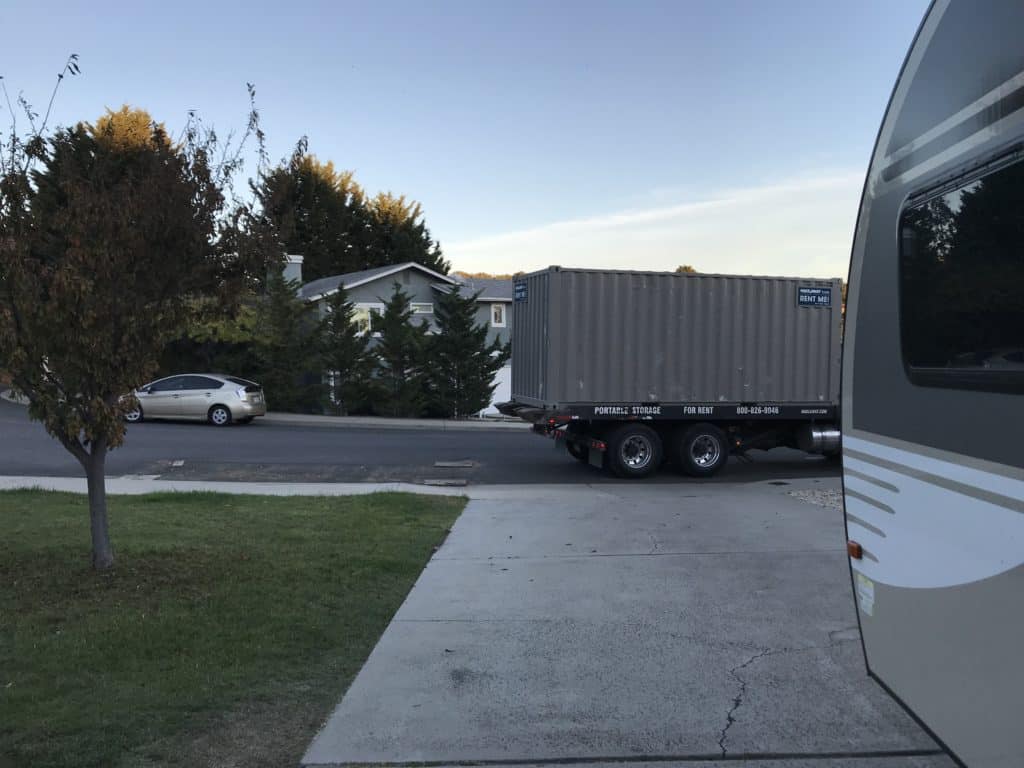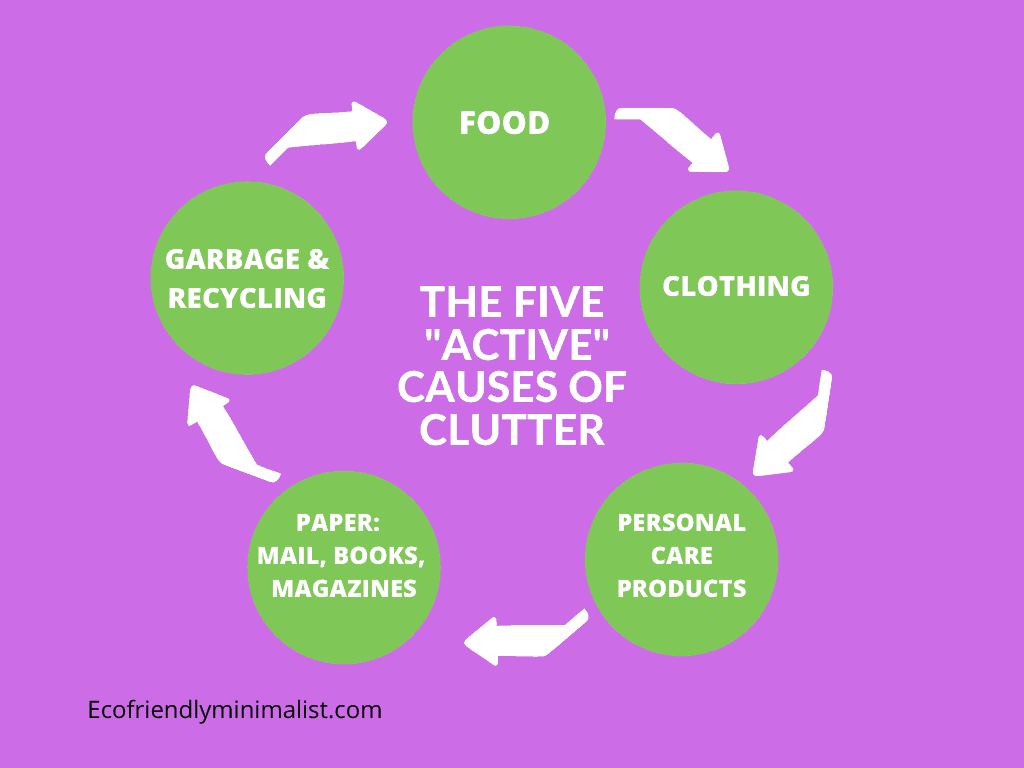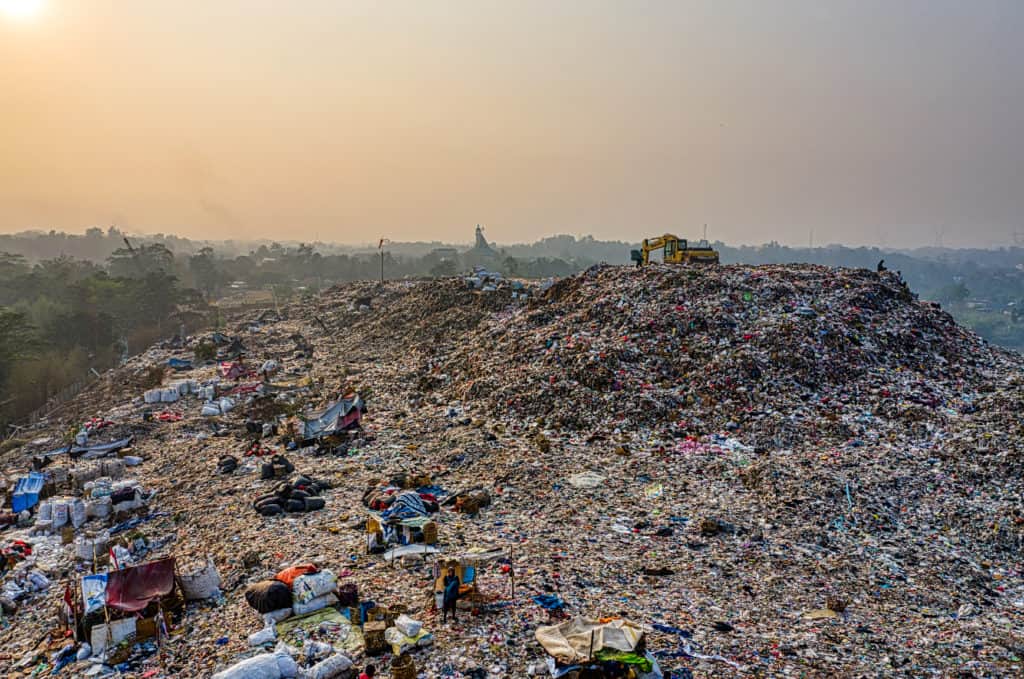Will I ever get there? Will I ever be a minimalist?
Didi Tweet
What a mudslide taught me about minimalism
Yes, a mudslide taught me about miminalism.
For years, I had tried to live a minimalist lifestyle. Early on, I discovered “The Minimalists” podcast, hosted by Josh and Ryan. Listening to these new, young voices inspired me. I purchased their documentary, Minimalism, before it was even released, back in 2016.
“Maybe this is the answer,” I thought. “How to live a meaningful life with less!”
Of course, I had also hopped on the “Kon-Mari” trail, with the book, The Life-Changing Magic of Tidying Up.
I started asking myself Marie Kondo’s famous (or infamous? tee hee!) question, “Does this spark joy?”
I feverishly purged my home year after year spending weekends cleaning the garage, giving away countless boxes and bags filled to the brim.
I tried everything! I was a master of organization. My systems had systems. But, I never felt like I made it.
“Will I ever get there? Will I ever be a minimalist?”
Mother Nature and Minimalist Me
Then, a few years ago, our lives changed overnight by a force unseen: a mudslide.
Our home was deemed unsafe and we had to move out immediately.
When we went to bed the night before, there was a light rain outside.
When I awoke at 2:30 a.m., my entire home, every square foot, was soaking in a few inches of brown, muddy water.
It turned out that the hill across the street from my house had collapsed during the night.
Muddy water filled my backyard, slowly seeping under the walls and into my home as we slept.
Now, you’re probably thinking . . . Well, she lost everything and that’s how she achieved minimalism, right? Wrong . . .
So . . . while living in a rental unit without ninety-nine percent of our belongings, I quickly discovered the true causes of clutter and overwhelm in our homes!
I discovered the FIVE ‘ACTIVE’ CAUSES OF CLUTTER and created ‘THE CLUTTER CYCLE,’ an explanation of why we (homemakers) feel like we never catch up.
But, don’t worry! This will set you free! Free from the bonds of perfection!
How did eco-friendly values find minimalism, you ask? Keep reading and explore my blog!
I’m so excited to share my findings with you!
THE FIVE ACTIVE CAUSES OF CLUTTER:
After a week at the new rental house, I realized that I had a new home to manage!
How can this be? I thought, when ninety-nine percent of our possessions are packed (by a lot of wonderful volunteers) into a 30-foot storage container (ugh!) on my driveway!

MY REALITY
“My (real) home was destroyed. It was still standing, but it had been stripped.
Three feet of drywall cut from every single wall, revealing the studs underneath. Floors, cabinets, doors, kitchen, and bathrooms all ripped out.
Nothing left but a shell, the ground coated in dried muddy residue, that when scraped, revealed layer after layer of fine powder.
To top it off, the air was dank, smelling like a toxic combination of cut grass and dirt.”
So, now that you’ve heard the truth of my reality, you can imagine that I wanted absolutely nothing to do with having to manage a rental house!!
This is how I learned the true causes of clutter and overwhelm, though, because I looked around and took stock of what was actually IN the rental house.
I looked at what we brought with us. It was next to nothing!
We brought our clothes. If you looked deeper, okay . . . we brought some toiletries. That’s it.
Why, then, was I feeling like I had an entire house to manage?
I had to clean the kitchen, the bathrooms, the floors – it was all the same.
I had to lug laundry down three flights of stairs to the garage.
That’s when it hit me: I didn’t fail at minimalism.
The truth is . . . running a home is a TON OF WORK!
Even when it’s just the basics, guys. If you stripped your house down to just the basics, it’s still a ton of work to manage your home!
“Let’s get real here. Most of the time, this burden falls on a woman, and women know how to pressure themselves to live up to certain standards. We’ve been trained well!”
I needed that experience where I had nothing but my clothes to help me to identify the true causes of basic daily clutter and overwhelm.
So, here it is, for you.
I want to tell you what I learned . . .
to help you to understand . . .
that even just the BASICS FOR LIVING . . . food, clothing, bathing, and unfortunately, bills . . .
creates a lot of work for us homemakers, us home managers.
I WANT TO TELL YOU THAT IF YOU CAN MANAGE THESE FIVE AREAS FIRST, YOUR LIFE CAN GET A LITTLE EASIER.
Decluttering your entire house is overwhelming. Why not start with “Active Daily Clutter” first?
Check this out:
HERE ARE MY FINDINGS:
What did we bring with us? Not much. We brought:
- Some of our clothes
- A few personal possessions
- A few personal care products.
Soon, we went to the grocery store and filled up the refrigerator and a few cabinets.
Then, the mail and paperwork started piling up. We added a few magazines and books.
Before long, garbage and recycling piled up in the kitchen. So, that added:
- Food
- Paper, books, and magazines
- Garbage and recycling
That’s it.
That’s all we had with us!
So, THE TRUE CAUSE OF DAILY CLUTTER AND OVERWHELM are actually these FIVE SIMPLE THINGS:
- FOOD (planning, shopping, cooking, cleaning, storage, management & disposal)
- CLOTHING (Shopping, storage management, care, accumulation, & purging)
- PERSONAL CARE PRODUCTS (Shopping, storage, accumulation, management & disposal)
- PAPER: MAIL, BOOKS, MAGAZINES (Accumulation, systems management, & purging)
- GARBAGE/RECYCLING (Accumulation & disposal)
THESE ARE THE BASICS, GUYS. THE STUFF WE NEED / HAVE / USE ON A DAILY BASIS.

Next, I had to clean the entire house! Who else was going to do it? There certainly wasn’t a maid service every day, like in a hotel!
Now it fell on me! The house manager! Can anyone relate?
The Clutter Cycle, an explanation of why we feel like we never catch up
Have you ever said to yourself, “If I can just do this better” or “if I can just organize that more” or “I just need to declutter” that everything will get better?”
I did! All of the time!
Having to manage a new (furnished rental) home helped me see that it wasn’t owning too much that was overwhelming me, it was managing daily living.
Once I realized that managing daily living mainly involved these FIVE ACTIVE CAUSES OF CLUTTER, (food, clothing, personal care products, paper, and garbage,) then I could break down the reason we never feel like we catch up. Here it is:
- SHOPPING
- ACCUMULATION
- STORAGE
- MANAGEMENT
- DISPOSAL/PURGING

We never feel like we can catch up because managing a home requires shopping which creates an accumulation of goods that requires storage, management, and eventually purging or disposal.
It is a constant, active, never-ending loop: a cycle.
THE CLUTTER CYCLE!
Example: You’ve been cleaning for days and everything looks good.
You relax for a minute. Take a break.
You don’t pick up after yourself once or twice. You’re tired. Off your game.
The next thing you know you’re walking around the house and it’s messy everywhere.
It only took a few days of relaxing . . . and you say to yourself . . . “I just cleaned this! I feel so defeated!”
Sound familiar?
You might be able to catch up for a minute but within days you can feel like you’re back to square one.
Of course, this usually falls on one person in the family. Think house manager. Oh, is that you? Of course, it is!
Think about the fact that all of the five categories of the clutter cycle either start with shopping or are the result of shopping.
But, it’s not shopping for pleasure. I’m talking about the most basic of purchases.
Our everyday needs: Food, clothing, and personal care products. These are the foundations of clutter.
Also think about the fact that we have to do this shopping regularly, at least once per week. That’s a lot of decision making.
And what else?
Management!
Constant Management!
Every day!
But we usually don’t even think about any of this. We just do it. Right?
SYNOPSIS:
Clutter and overwhelm are mainly caused by simple, everyday things:
- Food, Clothing, Personal Care, Paper, and Trash
- Eating, Bathing, Dressing (daily living)
We never feel like we catch up because it is “active” clutter, constantly moving and changing, and . . .
- it requires shopping, storage, management, and disposal/purging . . .
So, there’s your answer! Clutter and overwhelm are caused by five, simple, everyday things, and we never feel like we catch up because it is “active” clutter that requires shopping, storage, management, and, at some point, either purging or disposal.
So, what’s the remedy?
First things first – understand the problem:
Okay, so I learned that the true cause of daily clutter and overwhelm in our homes is just the daily living stuff, then I went on a “search and destroy” mission.
I’ve always been a responsible recycler and I thought I was doing my part. But, while researching, “how to reduce garbage and recycling,” I found out there’s more to it than that.
I learned that recycling material is actually becoming a big part of the problem.
Because of the cheap cost of manufacturing and goods, we are all buying too much, which creates a lot of waste.
Recycling facilities across the globe can’t process it fast enough, and it’s piling up! (Read more: Is Recycling Really good?)

Where Eco-Friendly values meet minimalism
Recycling materials are also causing clutter in our homes. It creates a daily clutter mess.
When I had a one-story ranch home, it was no problem. When I was living in a three-story townhouse: big problem!
Ultimately, the ECO-FRIENDLY theme kept popping up.
It’s kind of crazy, but if you look at every single one of the “five ‘active’ causes of clutter,” they all have an “eco” theme.
Each category of “active clutter” can be linked to ecological problems and can thereby be reduced and managed, helping not only you, as a home manager, but the wider world as well.
Think about it:
- Food waste
- Paper waste
- Recycling waste & accumulation
- Clothing waste
- Personal Care Products – known and unknown health risks – largely unregulated!
ALL OF THESE ARE A MASSIVE GLOBAL ISSUE!
I think this finding is really alarming and shouldn’t be ignored.
My research led me to the Zero Waste movement, as well as many other resources and methods on how to REDUCE, PLAN, AND MANAGE the ‘active clutter’ of daily living.
Below I’ve listed some basic information and action steps to bring awareness to each one of these topics.
Secondly, if you have any input or ideas that you would like to contribute, please leave me a note in the comments or drop me an email.
Finally, every week I’ll be writing about new topics to help you in each subject. Please check out my blog other posts for articles pertaining to those areas that you would like to tackle first.
Look out for my links to critical databases that will help you and your family stay safe and healthy. Or, you can go directly to The Environmental Working Group’s website:
My goal is for this blog to be a centralized resource for you. Keep reading for additional information and resources.
REMEDY: RPM –
REDUCE, PLAN, MANAGE
- Reduce, Reduce, Reduce – The less we have, the less we have to manage.
- Plan, Plan, Plan – Planning ahead helps to reduce what we buy and how much we’ll have to manage.
- Manage, Manage, Manage – Management systems reduce overwhelm. When you have a plan and a system, you don’t have to think about what or how you will do things.
How To Reduce How Much You Use AND help the environment too!
1. REDUCE PAPER: Incoming Mail, Books, Magazines
I’m starting with paper management because when I was doing research on “how to reduce paper consumption,” I was shocked at the magnitude of the problem that paper over-consumption causes for our earth. Check out these (approximate) facts:
- The pulp and paper industry is the 5th largest polluter in the world!
- 90% of paper comes from trees
- The rain forests are depleted by half since 1960
- Deforestation (loss of trees) affects wildlife, ecosystems, and climate.
I won’t go on and on, but there is a lot to learn.
I wasn’t kidding when I said, “eco-friendly minimalism is my journey!”
Also, paper management has been the biggest problem for me at home over the last many years! I just haven’t been able to master it. This is one area where I have tried every system, but my systems just grew bigger and bigger.
My goal is to reduce my systems and get my household paperwork management down to a very small system. I feel especially empowered to master it now that I better understand the global paper problem.
HERE ARE SOME WAYS TO REDUCE PAPER IN YOUR HOME:
- REDUCE MAIL – Place a “PLEASE, NO ADVERTISING MATERIALS!” sign inside your mailbox.
- If this doesn’t work, check with your local post office to learn how to manage advertisements
- Unsubscribe or cancel catalogs that you receive in the mail.
- CANCEL MAGAZINE SUBSCRIPTIONS OR SWITCH TO DIGITAL
- Read magazines online instead
- Borrow magazines from your library
- BOOKS – Get books from the library
- Use an e-reader and get your books in digital format.
- Many libraries let you check out digital books for a limited period of time.
- If you love to hold a real book, thrift stores have a TON of low-cost books. Libraries also hold book sales regularly.
- If you have lots of children’s books and want to purge them, many neighbourhoods now have little mini-libraries. Look for those and donate to other kids.
- SUBSCRIBE TO AUDIBLE.COM – I LOVE Audible! Audible is an audiobook subscription where you can listen to books, many read by the author, on your phone or other devices. I have over 200 books in my Audible library! I certainly don’t have room for that many books in my home!
Listening to books read by the author adds another dimension to the book and feels more personal.
Also, if you don’t like a book, Audible lets you exchange your credits.
IN YOUR HOME OFFICE
- Don’t PRINT – Try to keep as much data as possible on your computer.
- PAY BILLS ONLINE – Most banks offer a free Bill Payment service.
- RESIST THE URGE TO PICK UP FREE PRINTED MATERIALS – If we all refuse free materials it will, hopefully, lead to a reduction in the future and you will have less to manage and toss at home.
2. REDUCE FOOD and FOOD WASTE:
EAT WITH INTENTION – MEAL PLANNING
Most of us don’t think about what we eat. We just eat. We go on autopilot, thinking, “what do I feel like for dinner today?” At the grocery store, we grab whatever looks good.
But, if we learn to eat with intention, meaning, planning what we’re going to eat and buy, there are many benefits. Here are a few:
MEAL PLANNING REDUCES:
- The time & energy that you will spend grocery shopping.
- The amount of food that you bring into your home.
- The amount of food to manage and store in your home.
- The amount of time you will spend cleaning and managing your cabinets & refrigerator
- The amount of food that you will throw away.
TRY COMPOSTING
- Use your green waste container if your city allows for it.
- Use a countertop compost bin – you can store the bin in the fridge or freezer until you’re ready to dump it.
- Paper towels can be tossed into the compost bin as long as there is no oil on it, but it is better to replace paper with cloth hand towels.
3. REDUCE RECYCLING WASTE
REDUCE THE AMOUNT OF PACKAGING YOU BUY
Changing how and where you shop can have big impacts on your home and the world. If we can each reduce the packaging that we bring into our homes, there will be less recycling waste to process outside of our homes.
Here are some things that you can do:
- Learn about shopping at grocery stores that have a bulk bin section.
- Buy from local bakeries or grocery store bakeries (bring your own cloth bags.)
- Shop at your local farmer’s market (bring your own cloth bags.)
- Stop buying single-serve food items.
- Buy everything else in glass, cans, or cardboard.
- Ditch plastics (plastic waste is one of the world’s most pressing environmental issues.)
- CHECK WITH YOUR CITY’S WASTE MANAGEMENT PROGRAM
- Learn about how your city manages trash and recycling.
- Find out what type of recycling they accept (for plastics, there is a number on the bottom) so that you can sort your recycling waste properly.
- Find out if they allow soiled recycling materials or if you have to rinse before tossing into the bin so that you don’t contaminate the rest of the load.
- REPLACE DISPOSABLE PRODUCTS WITH REUSABLE PRODUCTS – Think about replacing :
- Cloth towels instead of paper towels,
- Cloth napkins instead of paper napkins,
- Cloth grocery bags instead of plastic grocery bags,
- Cloth vegetable bags instead of thin plastic produce bags,
- Good quality reusable water bottles instead of single-use plastic water bottles,
- Portable coffee cups instead of throwaway cups (Starbucks will comply plus give a 10% discount)
- Glass and stainless steel containers for food storage instead of plastic wrap/bags
- CONSIDER TAKING A FIELD TRIP OR TOUR OF YOUR CITY’S WASTE MANAGEMENT FACILITY
- This can be extremely enlightening. You can learn a lot, and if you have kids, they also can learn and help at home with the recycling. I’ll never forget what I learned and SAW when I went on a field trip to our local waste plant with my son when he was in the third grade.
4. REDUCE YOUR CLOTHING
- Dress with Intention – If you have a plan, you’ll bring in less and have less to manage.
- Create a capsule wardrobe – A capsule wardrobe generally has a limited number of items, usually between 30-40;
- is usually planned seasonally;
- can make dressing faster and easier;
- will make clothing management easier.
- Stop impulse buying – bad habits are hard to break, especially when we see cheap clothing or sales.
- Impulse buying adds to our clutter in our closets, especially when we don’t return items that don’t work.
- Nix fast-fashion – buy natural fabrics – Buying fast fashion goes along with impulse buying, considering that items are usually inexpensive to acquire and adds to our cluttered closets.
5. REDUCE YOUR PERSONAL CARE PRODUCTS
We don’t generally think about planning for our personal care products purchases, however, it is probably one of the most important things we can do, besides planning what we eat.
What we put ON our bodies is just as important as what we put IN our bodies.
Many products that are sold to us are not well regulated. With cancer and other illnesses on the rise, learning about the ingredients in our personal care products is a first-line of defence.
Since that is an overwhelming task, I recommend checking the database of THE ENVIRONMENTAL WORKING GROUP (EWG.) The Environmental Working Group’s Database contains over 1,500 personal care products.
Check out the EWG database here:
https://www.ewg.org/ewgverified/personal-care.php
START HERE:
- Take inventory of what you own
- Check THE ENVIRONMENTAL WORKING GROUP DATABASE for toxic ingredients
- Toss the bad stuff
- Create a Personal Care Products list of essentials
- Reduce the number of products that you put on your body
- Reduce plastic bottles – replace with bar shampoo and bar soap
- Reducing your personal care products consumption will also make managing and purging your bathroom easier
The Last Thing You Need to Know about eco-friendly minimalism
- There is a lot of information here! Please don’t get overwhelmed.
- Begin by choosing just ONE of the five categories (Food, clothing, personal care products, paper, garbage/recycling)
- Pick the category that is easiest or;
- Pick the category that you are most interested in changing
- REMEMBER:
- This is a practice, a journey
- Don’t try to be perfect
- Please subscribe and join me on this journey.
- I’d love to hear about your experiences.
- Feel free to comment. I’m looking forward to hearing from you.





